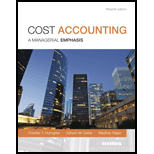
Cost Accounting, Student Value Edition (15th Edition)
15th Edition
ISBN: 9780133428858
Author: Charles T. Horngren, Srikant M. Datar, Madhav V. Rajan
Publisher: PEARSON
expand_more
expand_more
format_list_bulleted
Question
Chapter 3, Problem 3.29E
1.
To determine
Cost-Volume-Profit Analysis (CVP Analysis):
CVP Analysis is a tool of cost accounting that measures the effect of variation on operating profit and net income due to the variation in proportion of sales and product costs.
Break-Even Point:
Break-even point is a point of sales where company can cover all its variable and fixed costs. It is a point of sales where revenue generated is equal to the total costs. Thus, profit is zero at this level of sales.
To compute: Break-even point in units.
2.
To determine
To compute: Break-even point in units and operating income.
3.
To determine
To compute: Break-even point in case grant is received.
Expert Solution & Answer
Want to see the full answer?
Check out a sample textbook solution
Students have asked these similar questions
Kindly help me with this General accounting questions not use chart gpt
Calculate standard rate per direct labor hour general accounting question correct option
Please given correct answer for Financial accounting question I need step by step explanation
Chapter 3 Solutions
Cost Accounting, Student Value Edition (15th Edition)
Ch. 3 - Define costvolumeprofit analysis.Ch. 3 - Describe the assumptions underlying CVP analysis.Ch. 3 - Distinguish between operating income and net...Ch. 3 - Prob. 3.4QCh. 3 - Prob. 3.5QCh. 3 - Why is it more accurate to describe the subject...Ch. 3 - CVP analysis is both simple and simplistic. If you...Ch. 3 - Prob. 3.8QCh. 3 - Prob. 3.9QCh. 3 - Give an example of how a manager can decrease...
Ch. 3 - Give an example of how a manager can increase...Ch. 3 - What is operating leverage? How is knowing the...Ch. 3 - There is no such thing as a fixed cost. All costs...Ch. 3 - Prob. 3.14QCh. 3 - In CVP analysis, gross margin is a less-useful...Ch. 3 - Prob. 3.16ECh. 3 - Prob. 3.17ECh. 3 - Prob. 3.18ECh. 3 - Prob. 3.19ECh. 3 - CVP exercises. The Doral Company manufactures and...Ch. 3 - Prob. 3.21ECh. 3 - Prob. 3.22ECh. 3 - Prob. 3.23ECh. 3 - Prob. 3.24ECh. 3 - Prob. 3.25ECh. 3 - Prob. 3.26ECh. 3 - Sales mix, new and upgrade customers. Chartz 1-2-3...Ch. 3 - Prob. 3.28ECh. 3 - Prob. 3.29ECh. 3 - Prob. 3.30ECh. 3 - Prob. 3.31ECh. 3 - Prob. 3.32ECh. 3 - CVP analysis, service firm. Lifetime Escapes...Ch. 3 - Prob. 3.34PCh. 3 - Prob. 3.35PCh. 3 - Prob. 3.36PCh. 3 - Prob. 3.37PCh. 3 - CVP analysis, shoe stores. The HighStep Shoe...Ch. 3 - Prob. 3.39PCh. 3 - Prob. 3.40PCh. 3 - Prob. 3.41PCh. 3 - Prob. 3.42PCh. 3 - Prob. 3.43PCh. 3 - Prob. 3.44PCh. 3 - Prob. 3.45PCh. 3 - Sales mix, two products. The Stackpole Company...Ch. 3 - Prob. 3.47PCh. 3 - Prob. 3.48PCh. 3 - Deciding where to produce. (CMA, adapted) Portal...
Knowledge Booster
Similar questions
- Please answer the following requirements on these general accounting questionarrow_forwardFinancial Accountingarrow_forwardTwo investors are evaluating Anywhere e-SIM Ltd.’s stock for possiblepurchase. They agree on the expected value of D1 and also on theexpected future dividend growth rate. Further, they agree on theriskiness of the stock. However, one investor normally holds stocksfor 2 years, while the other normally holds stocks for 10 years.Is it true that they should both be willing to pay the same price forthis stock? Explain based on how stocks are valued and provide anumerical example to support your arguments.arrow_forward
arrow_back_ios
SEE MORE QUESTIONS
arrow_forward_ios
Recommended textbooks for you
